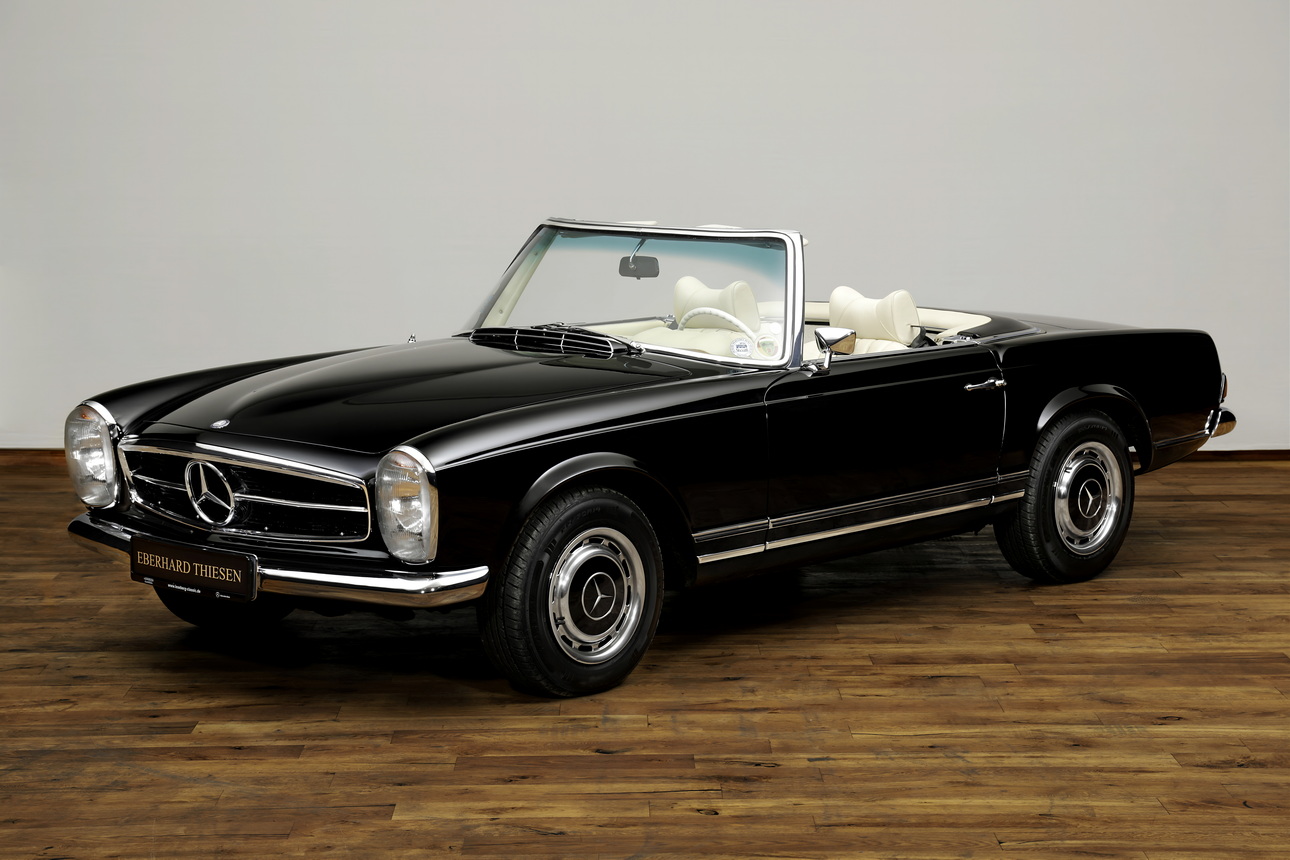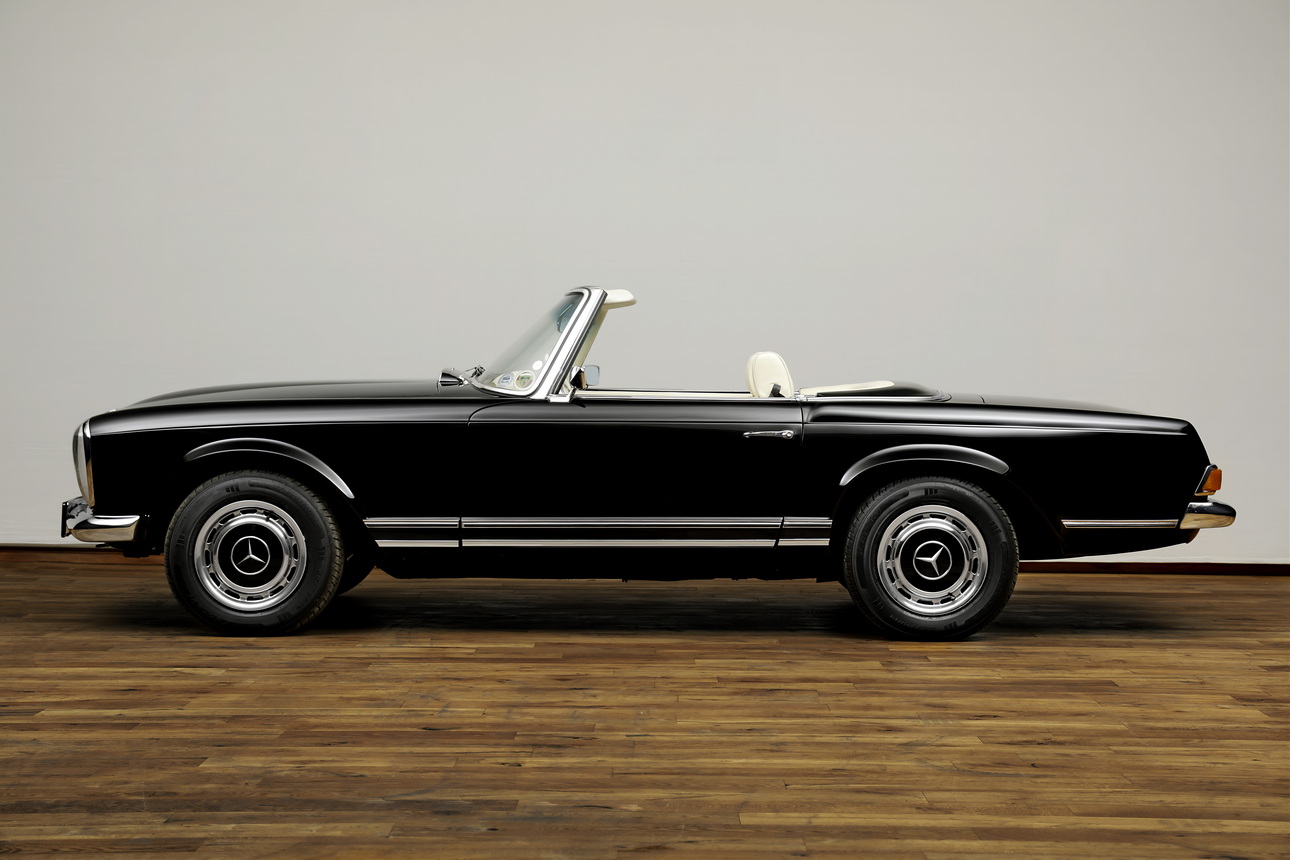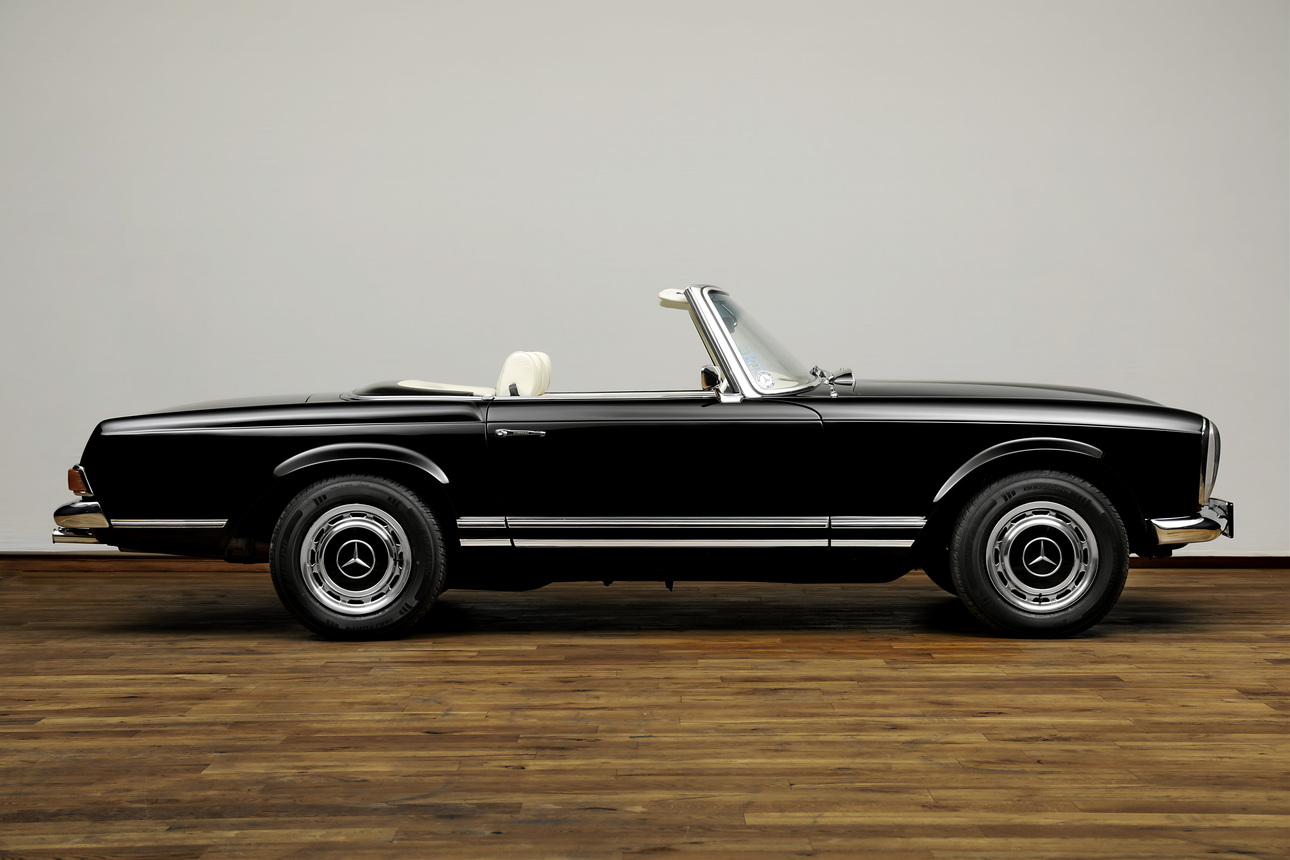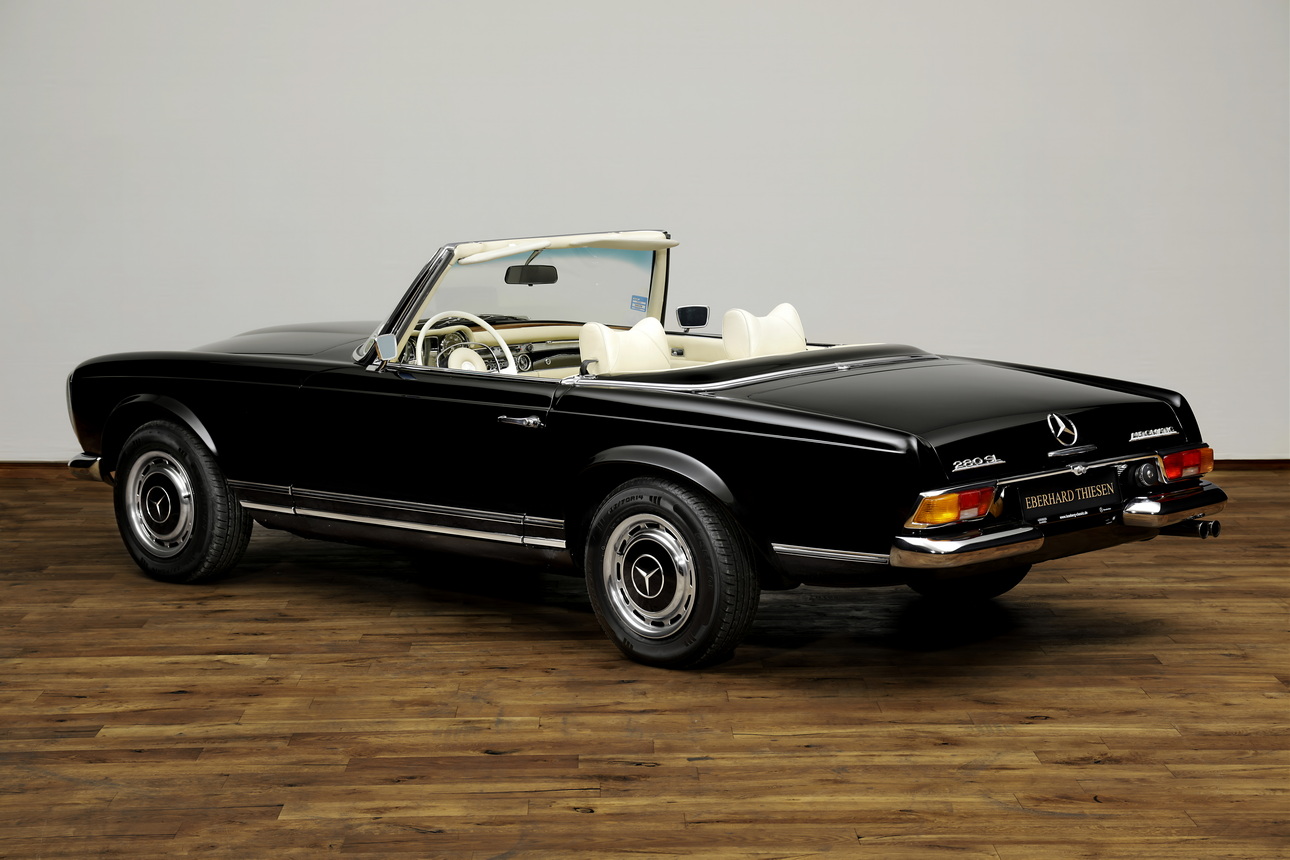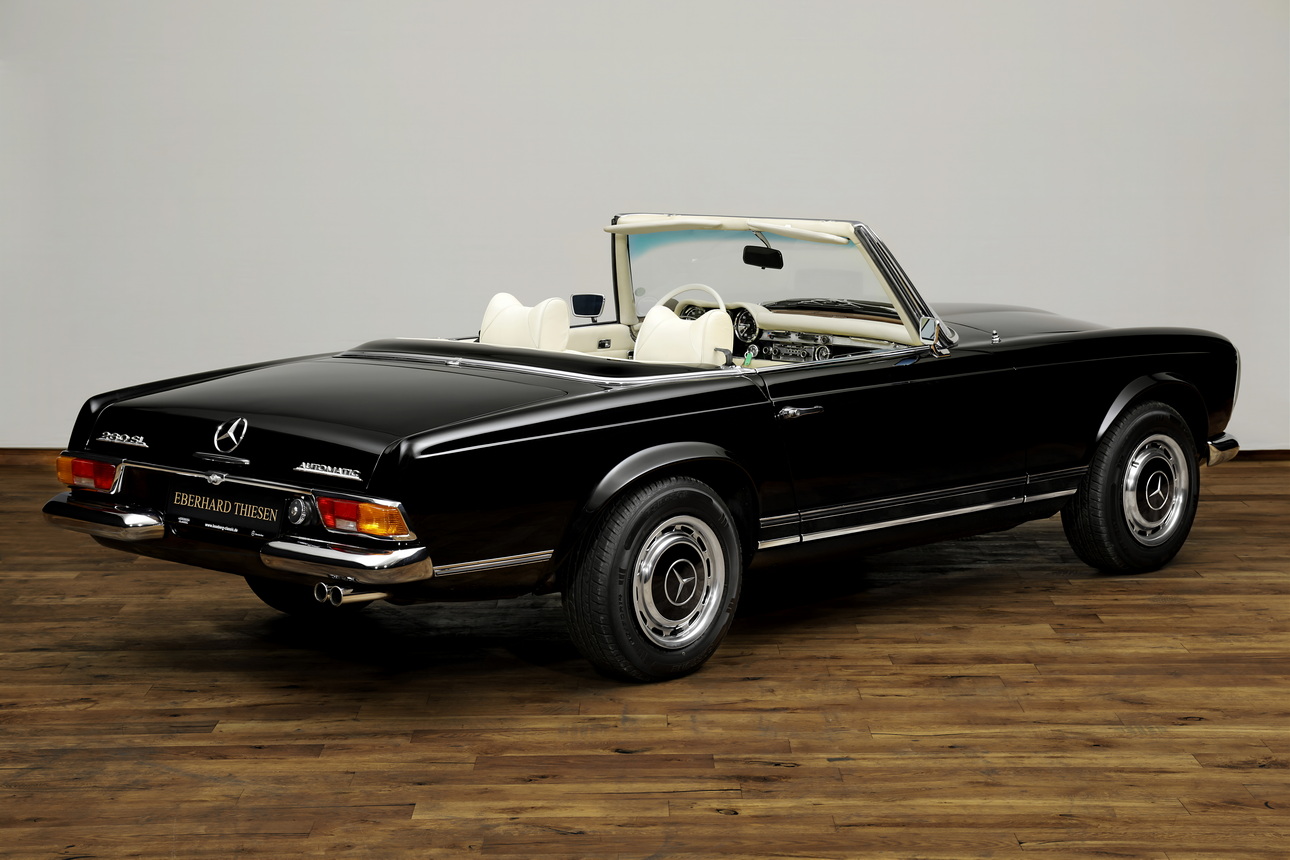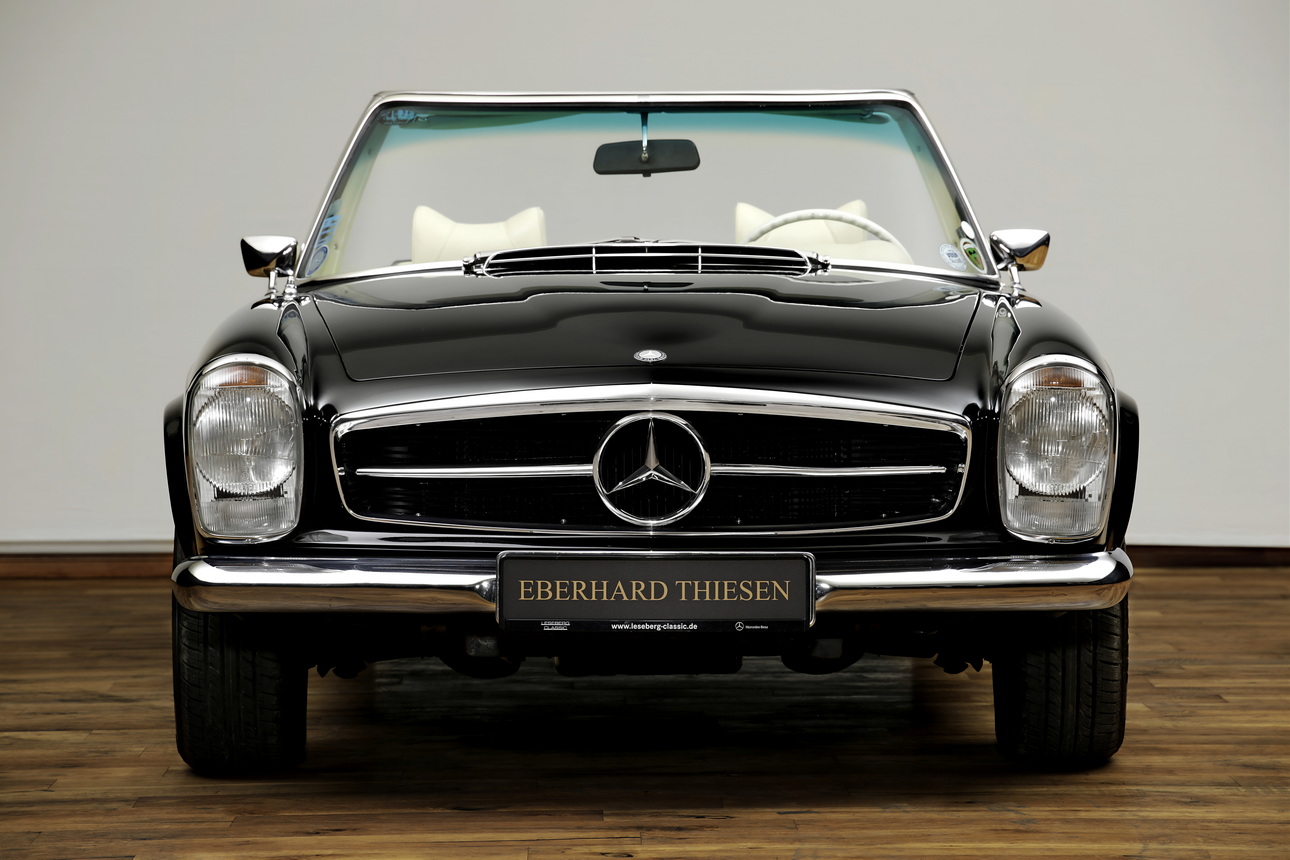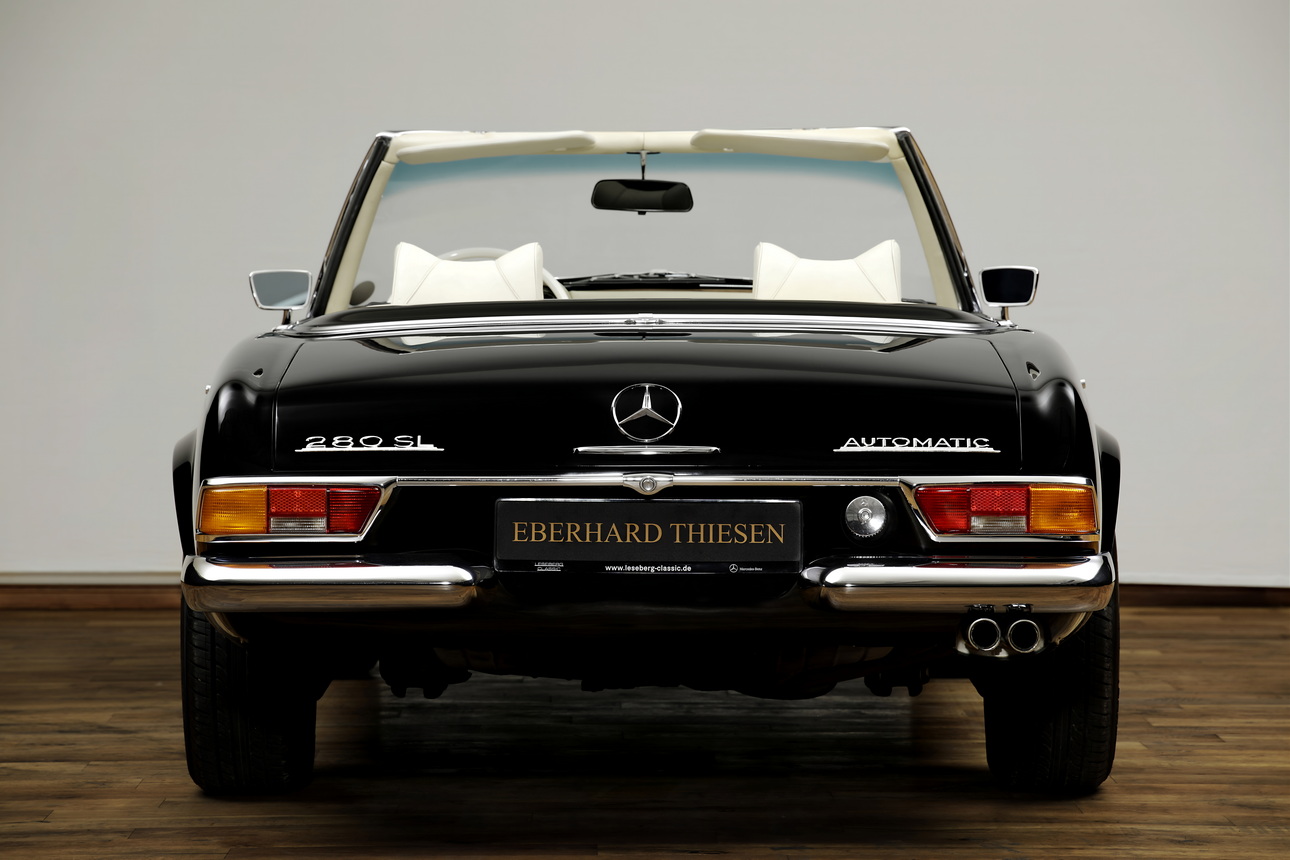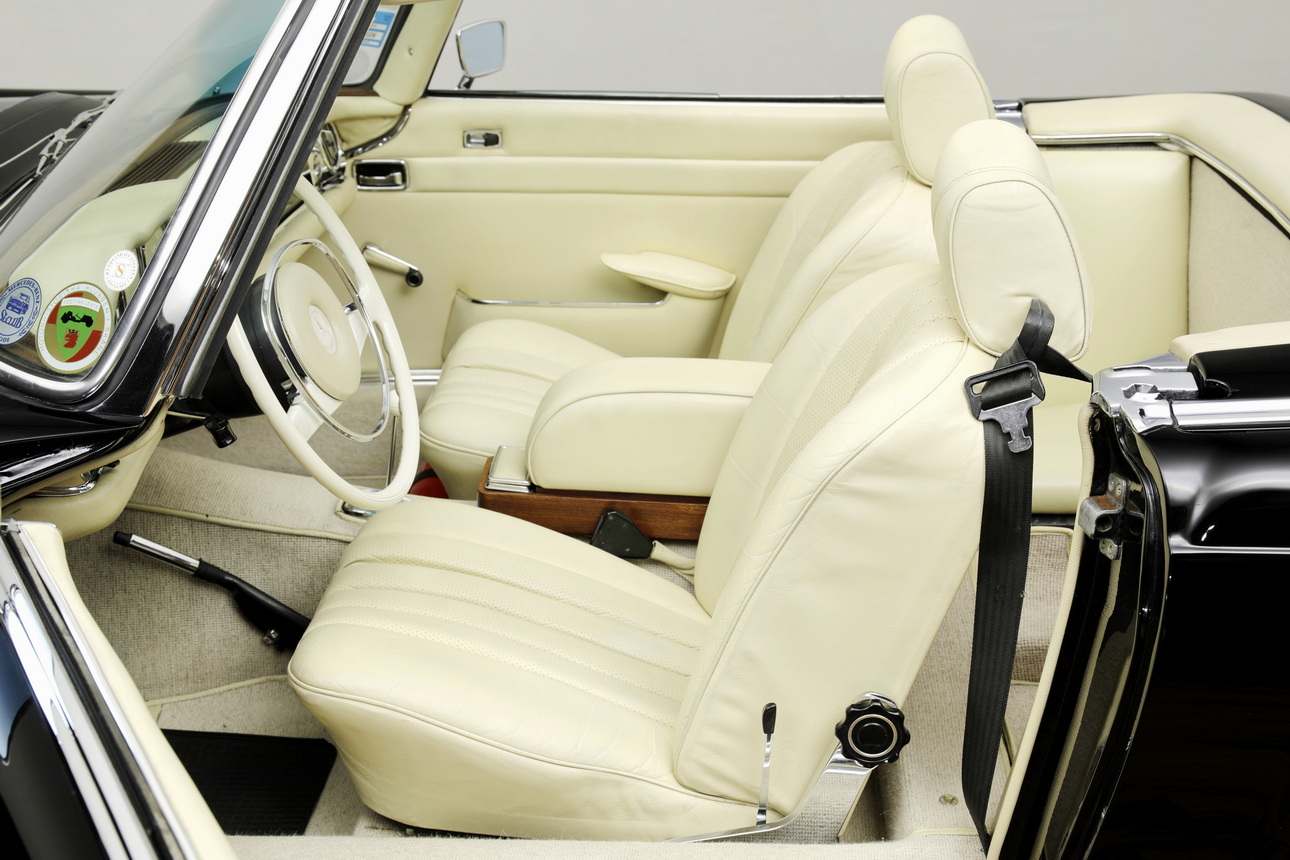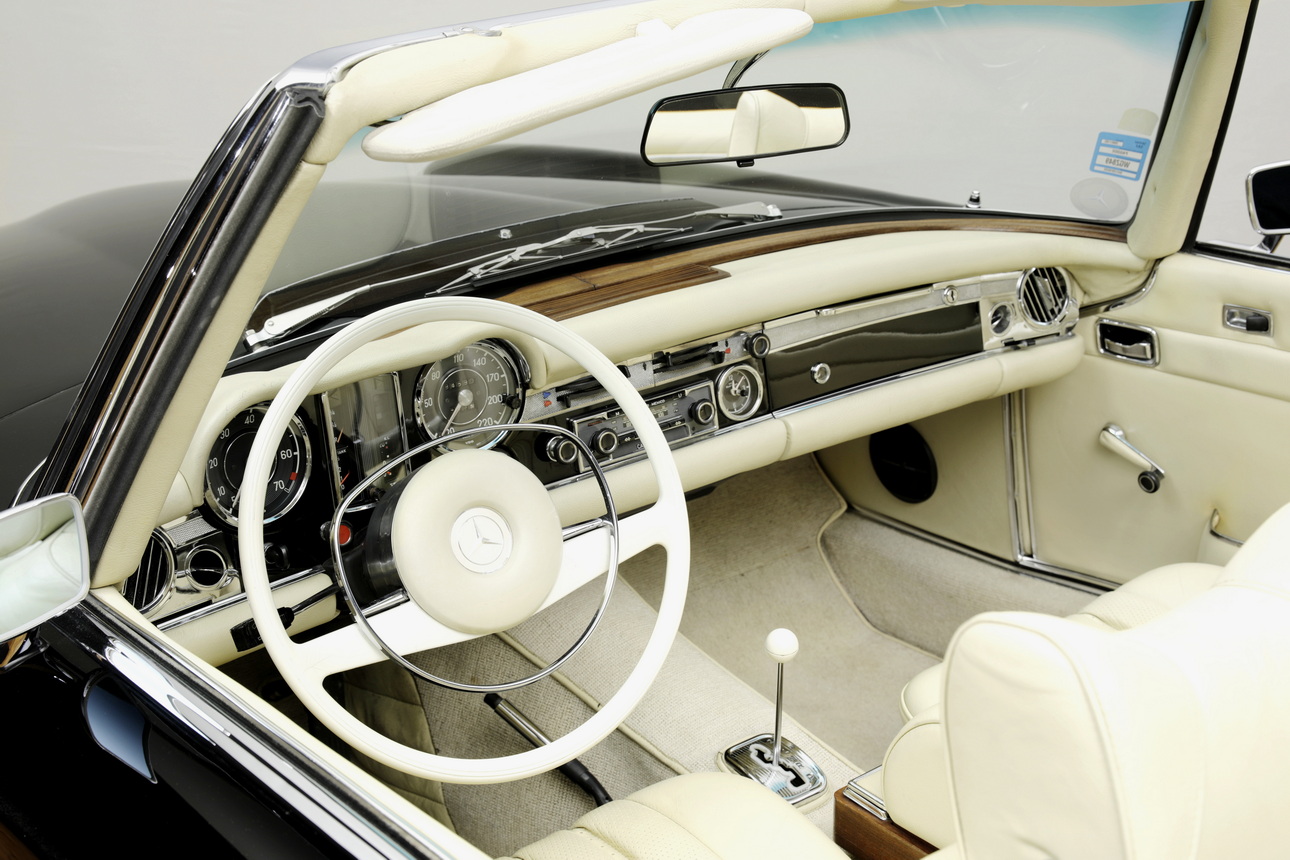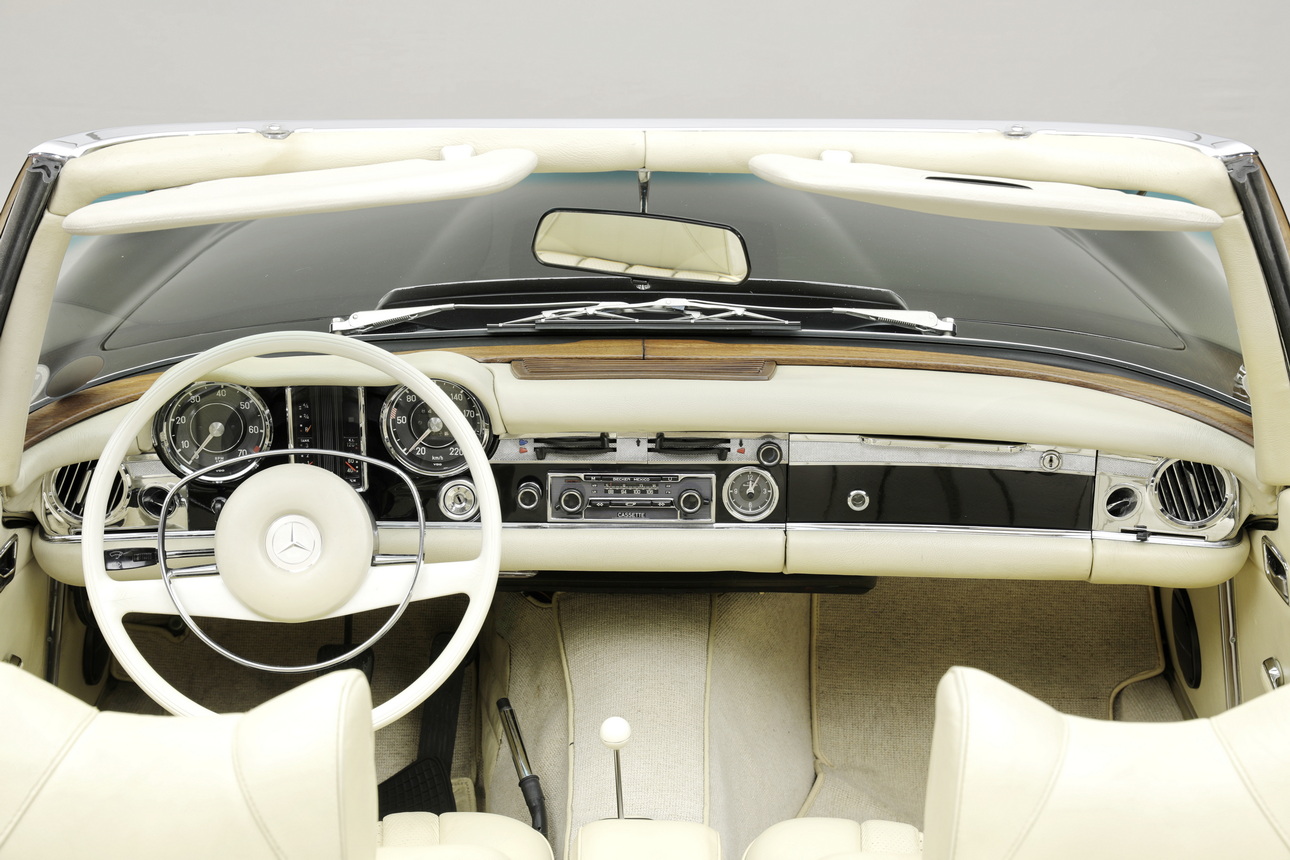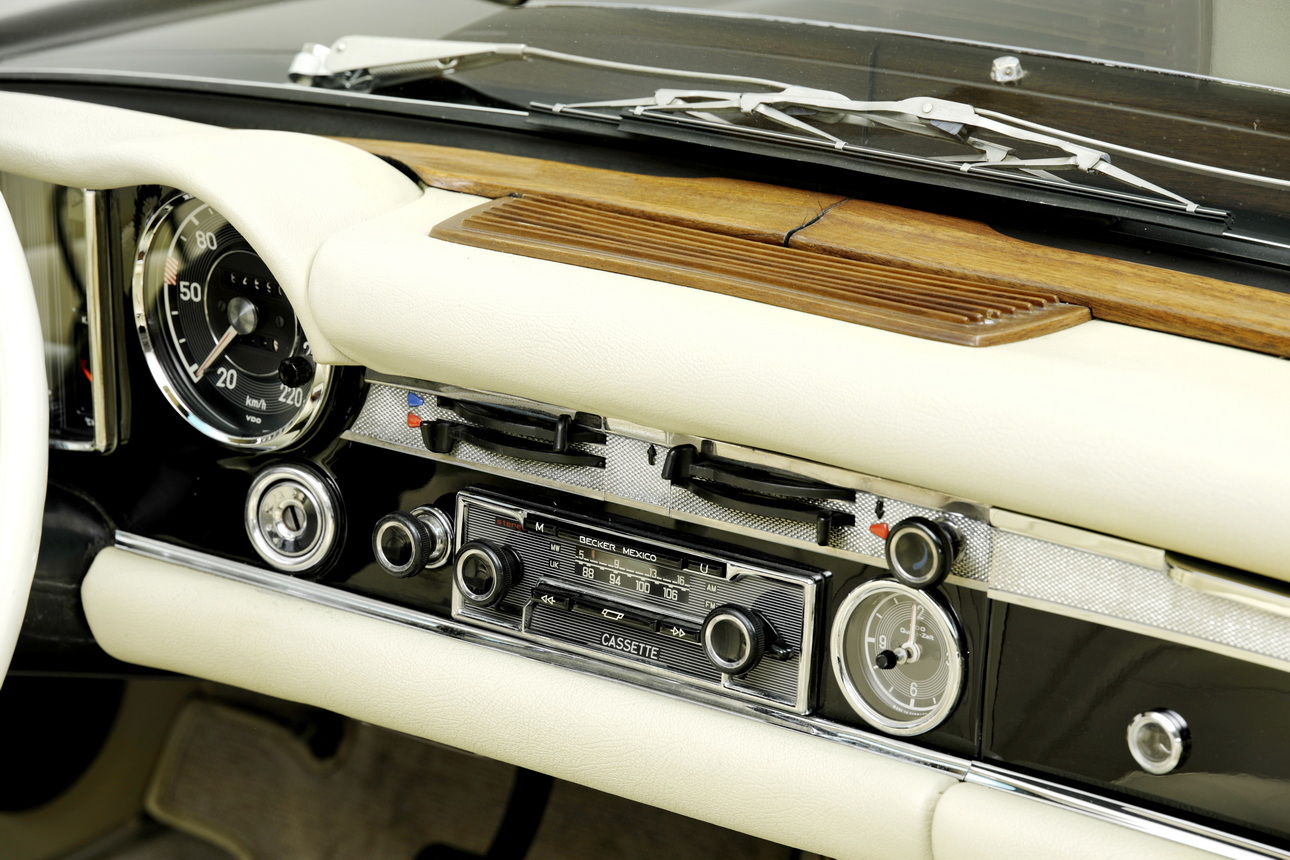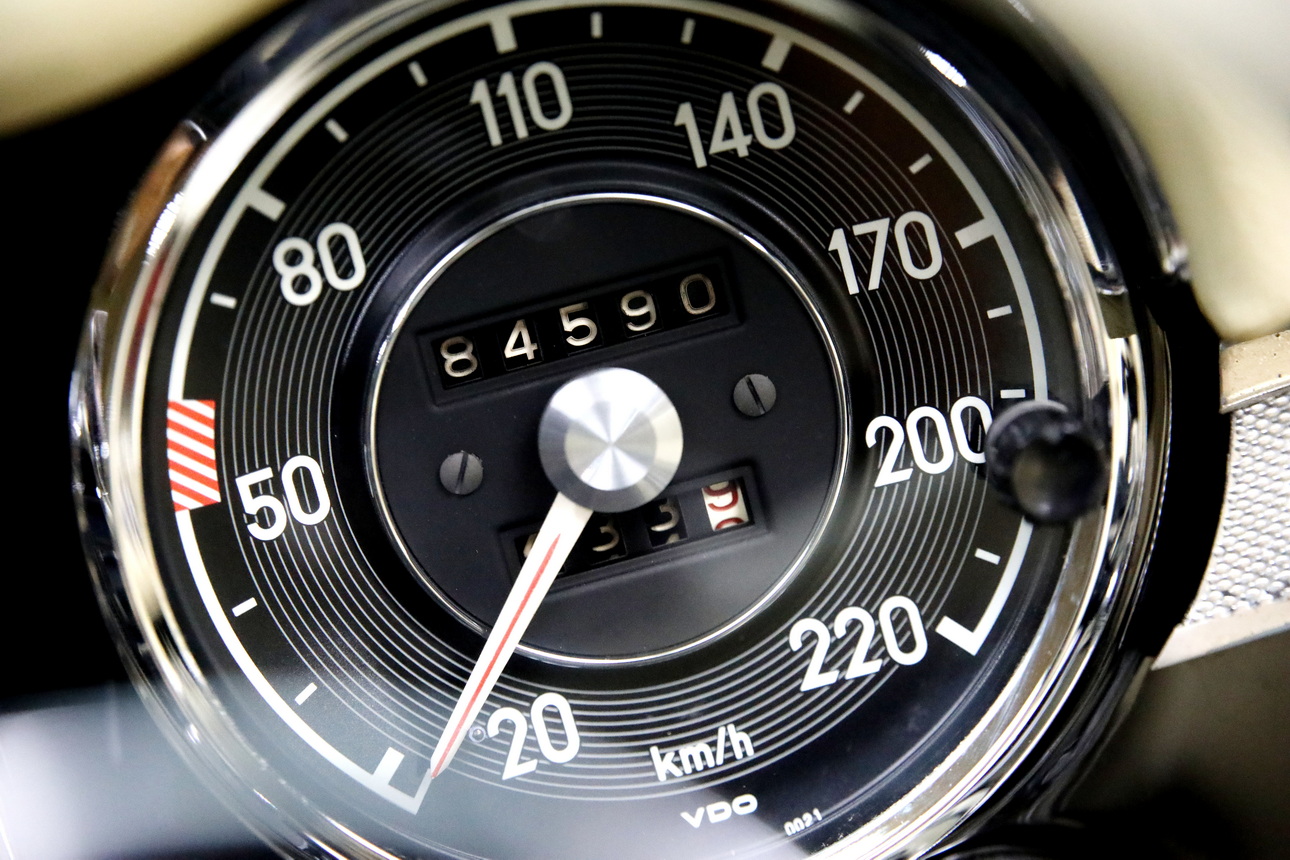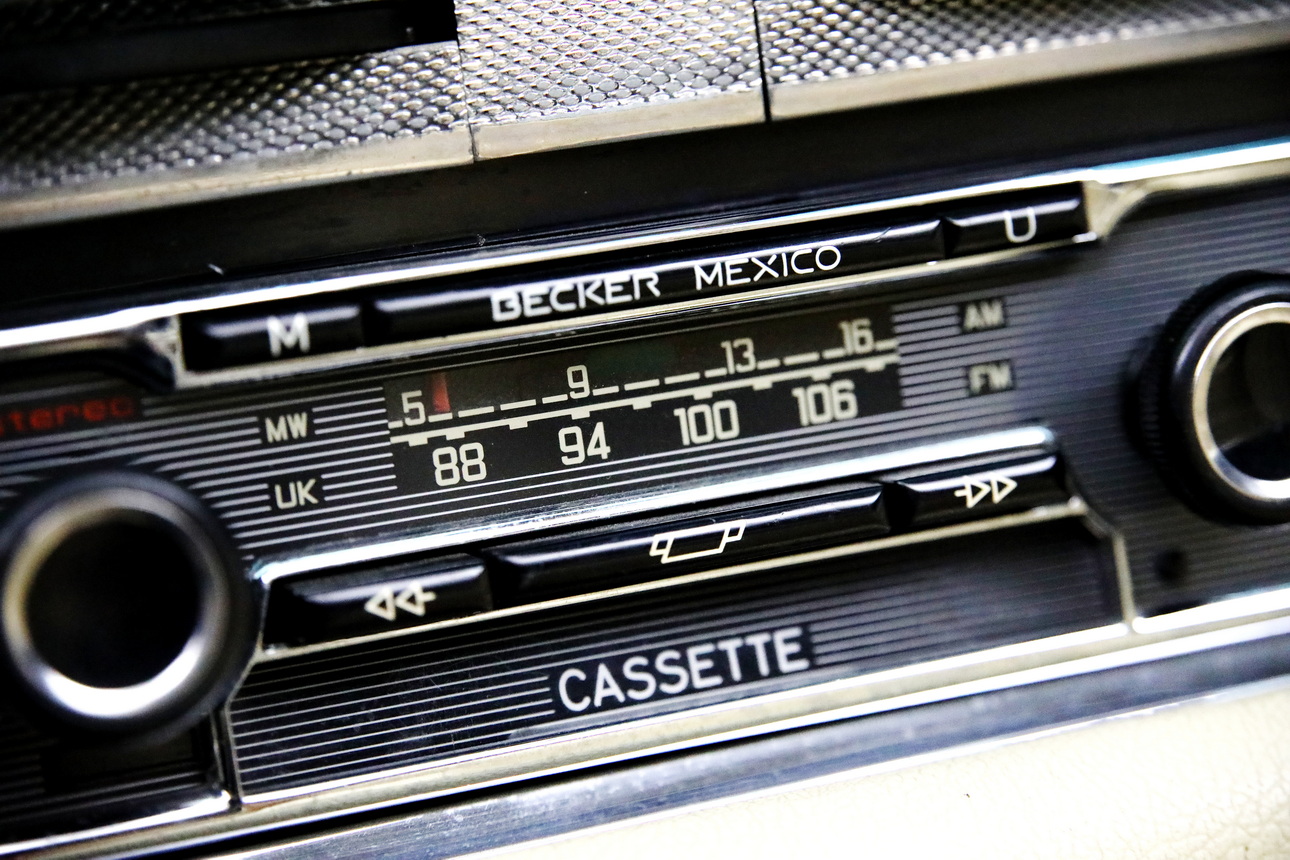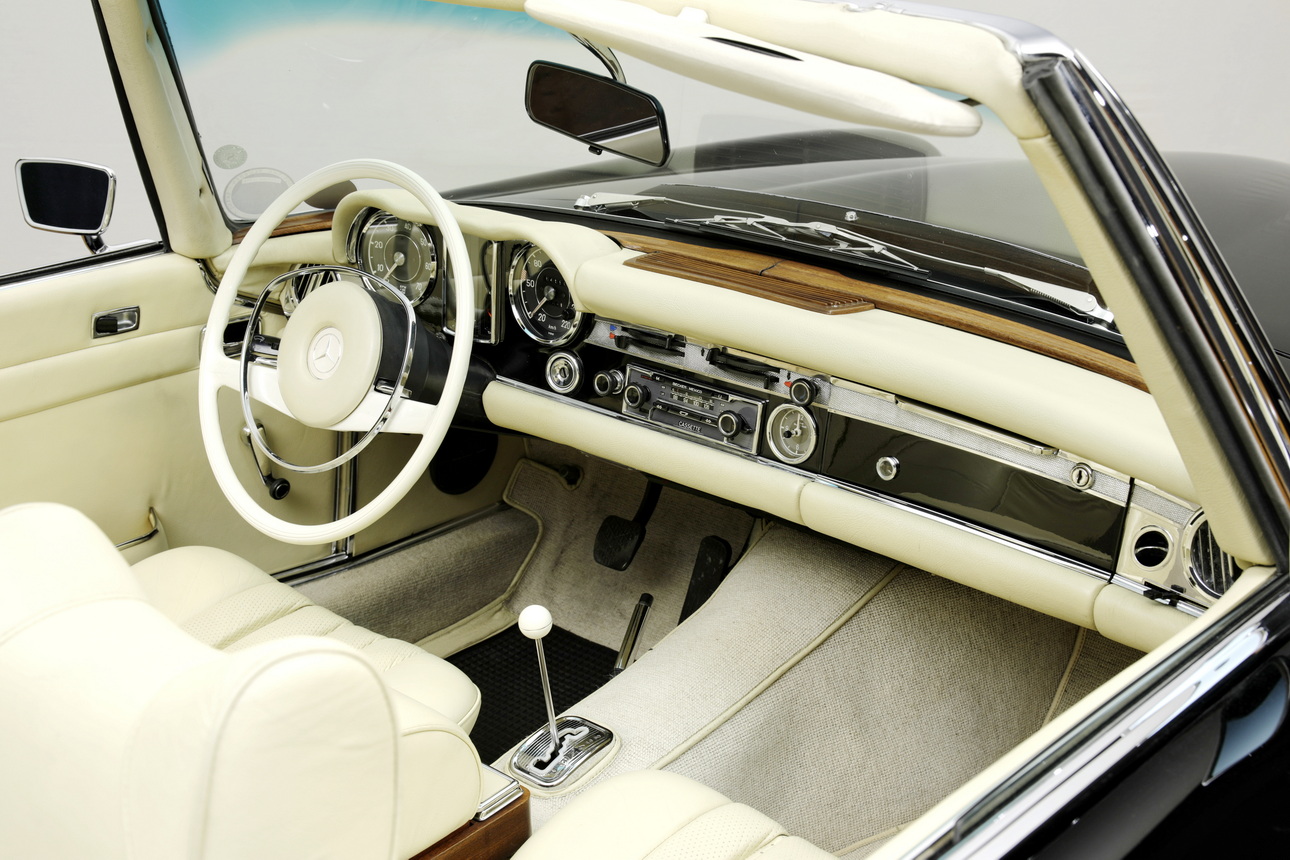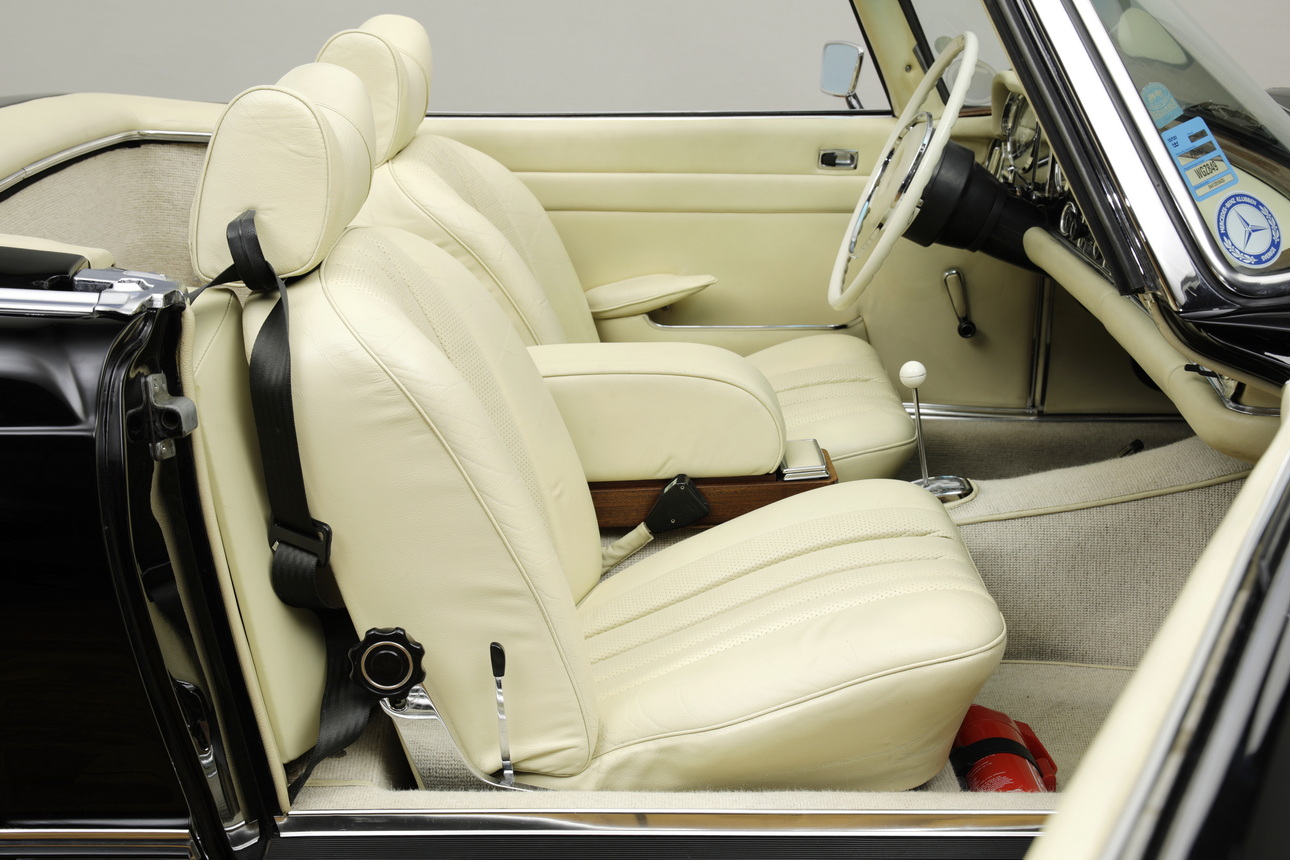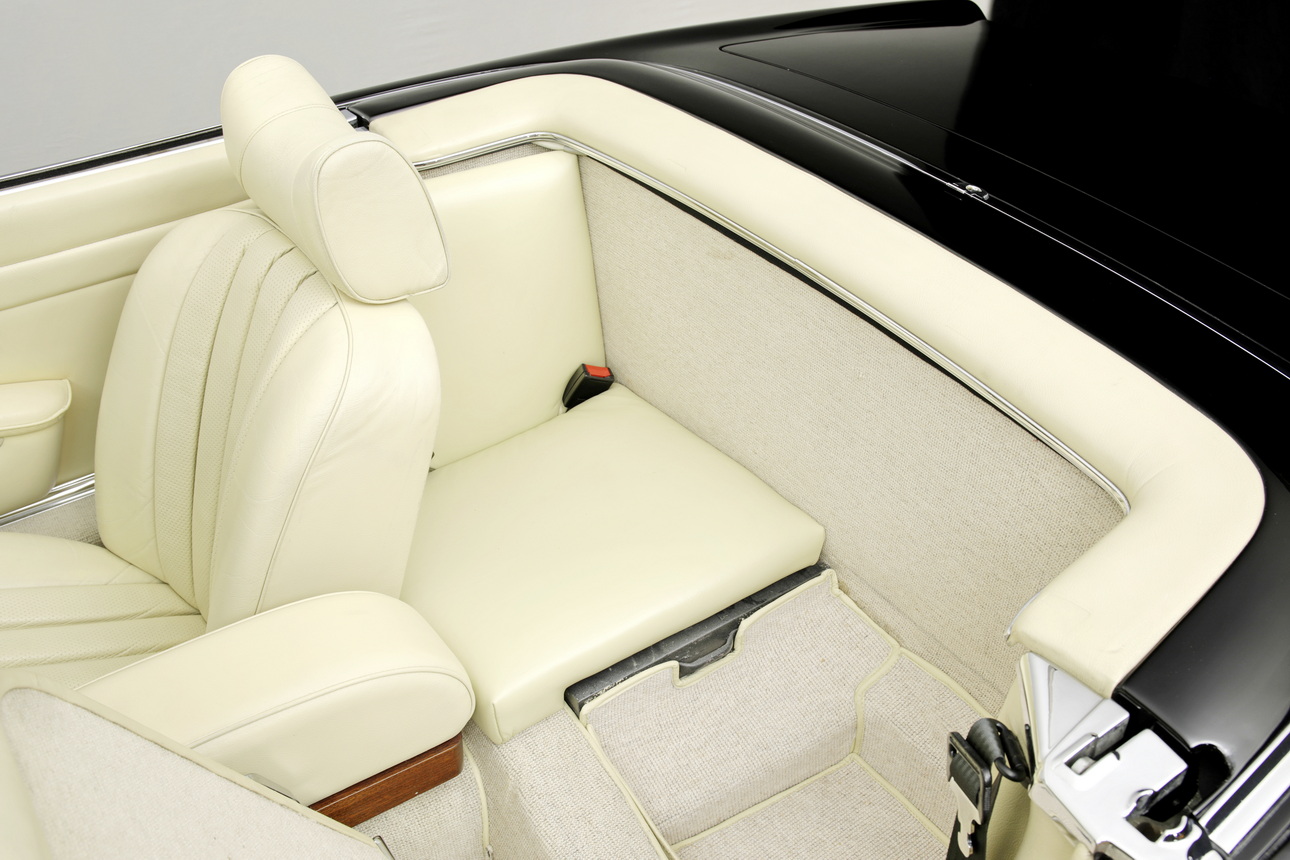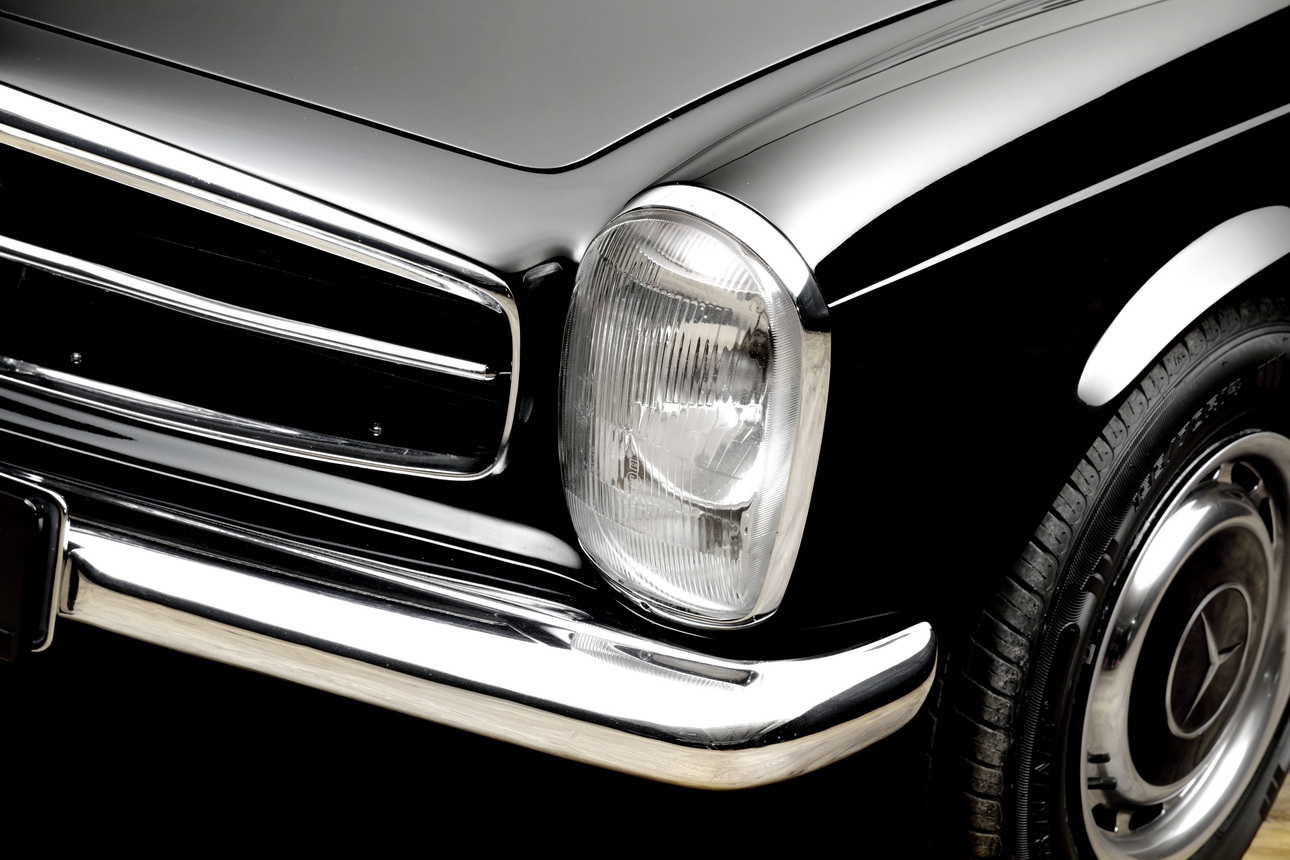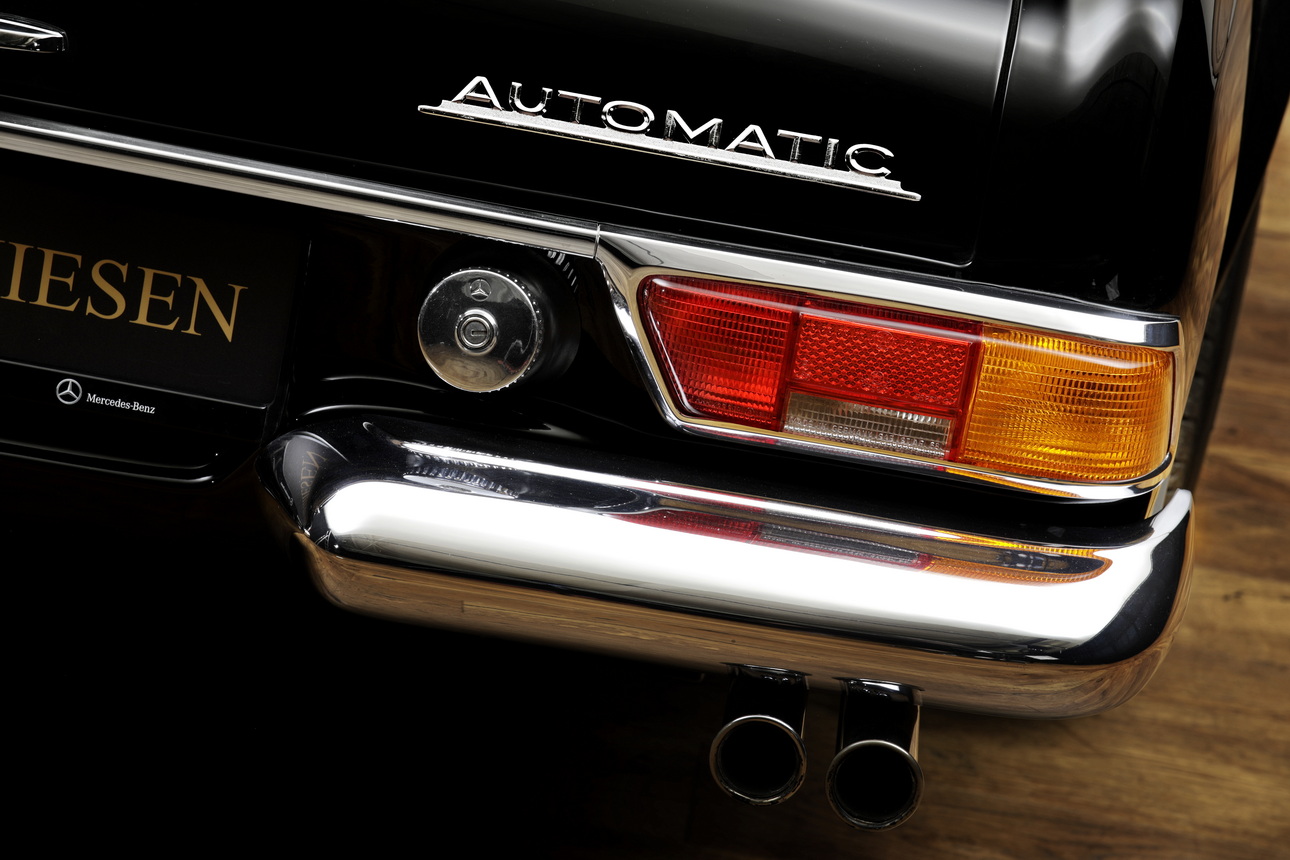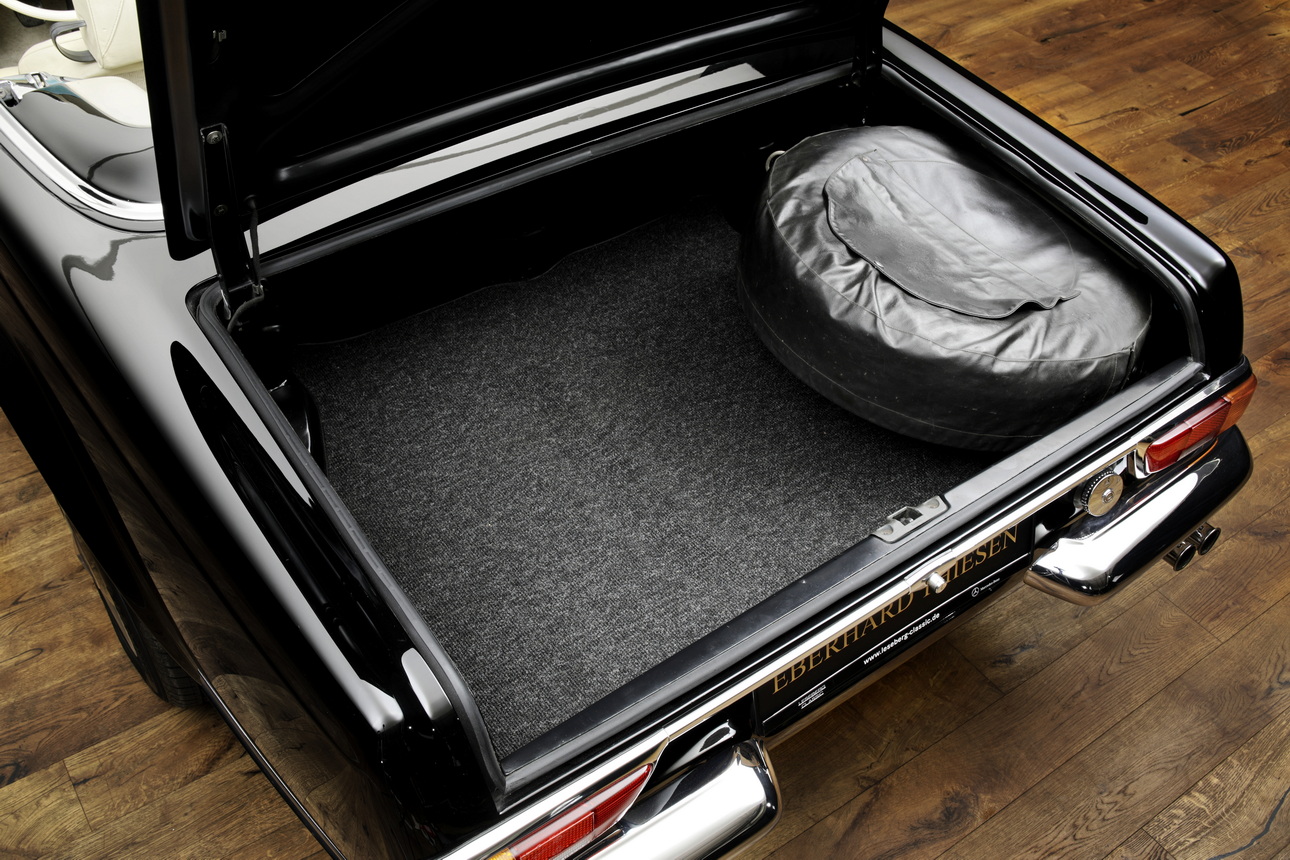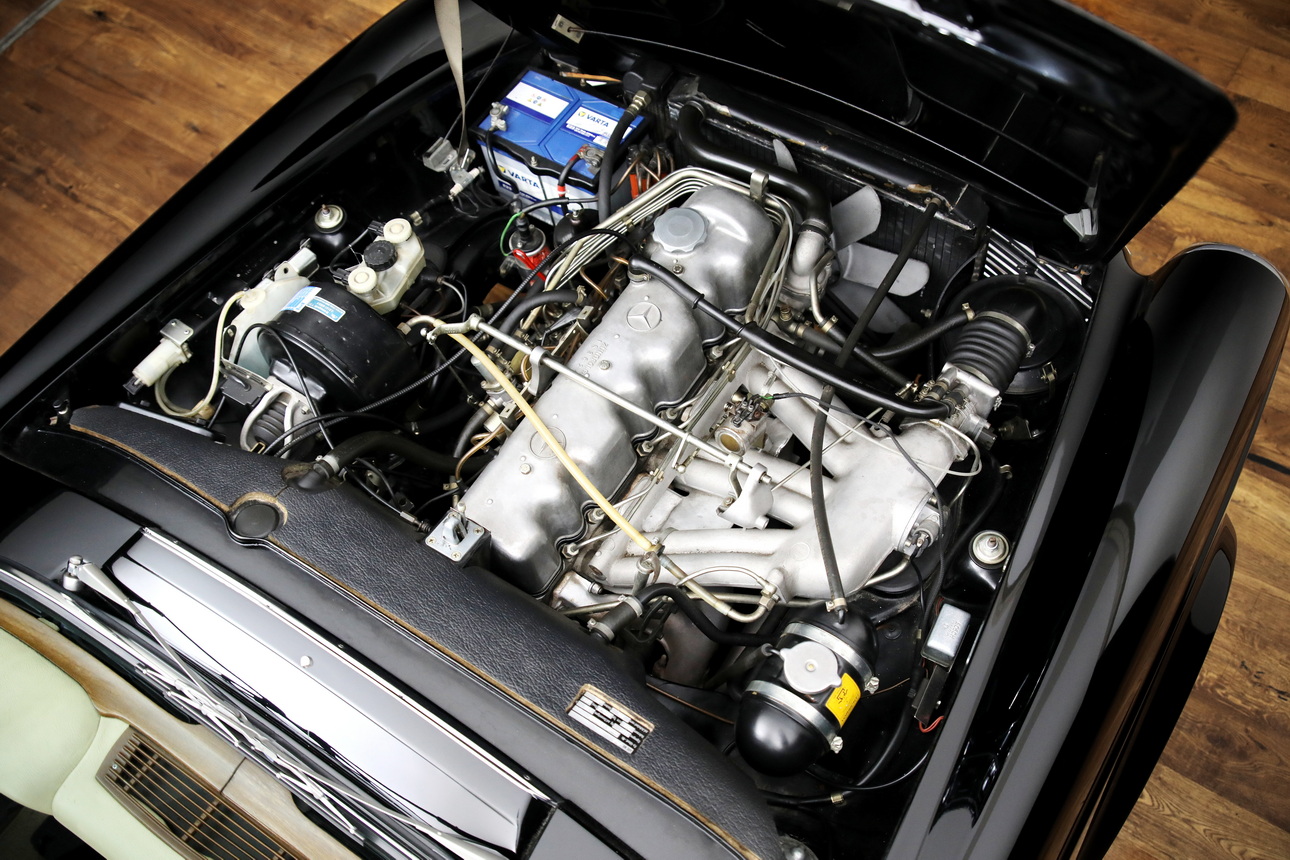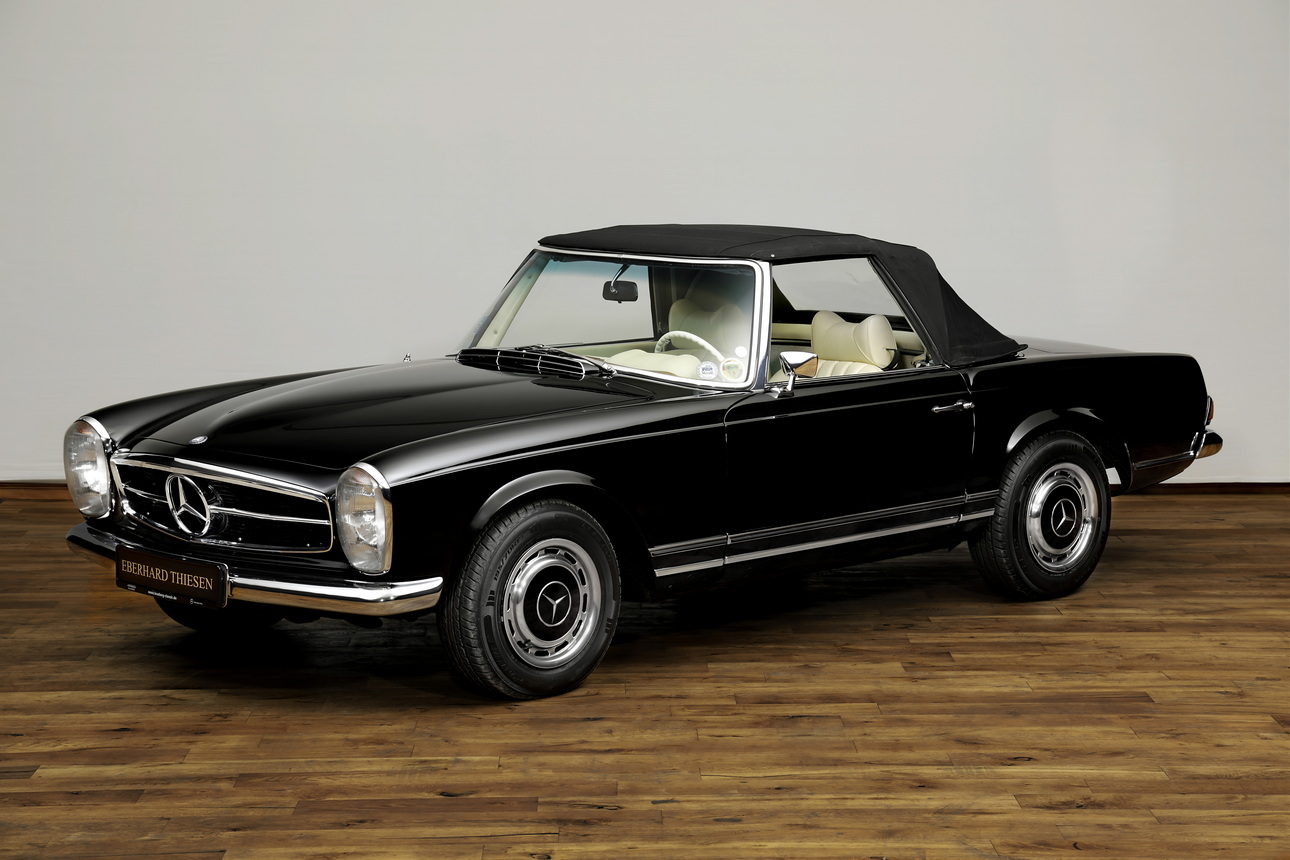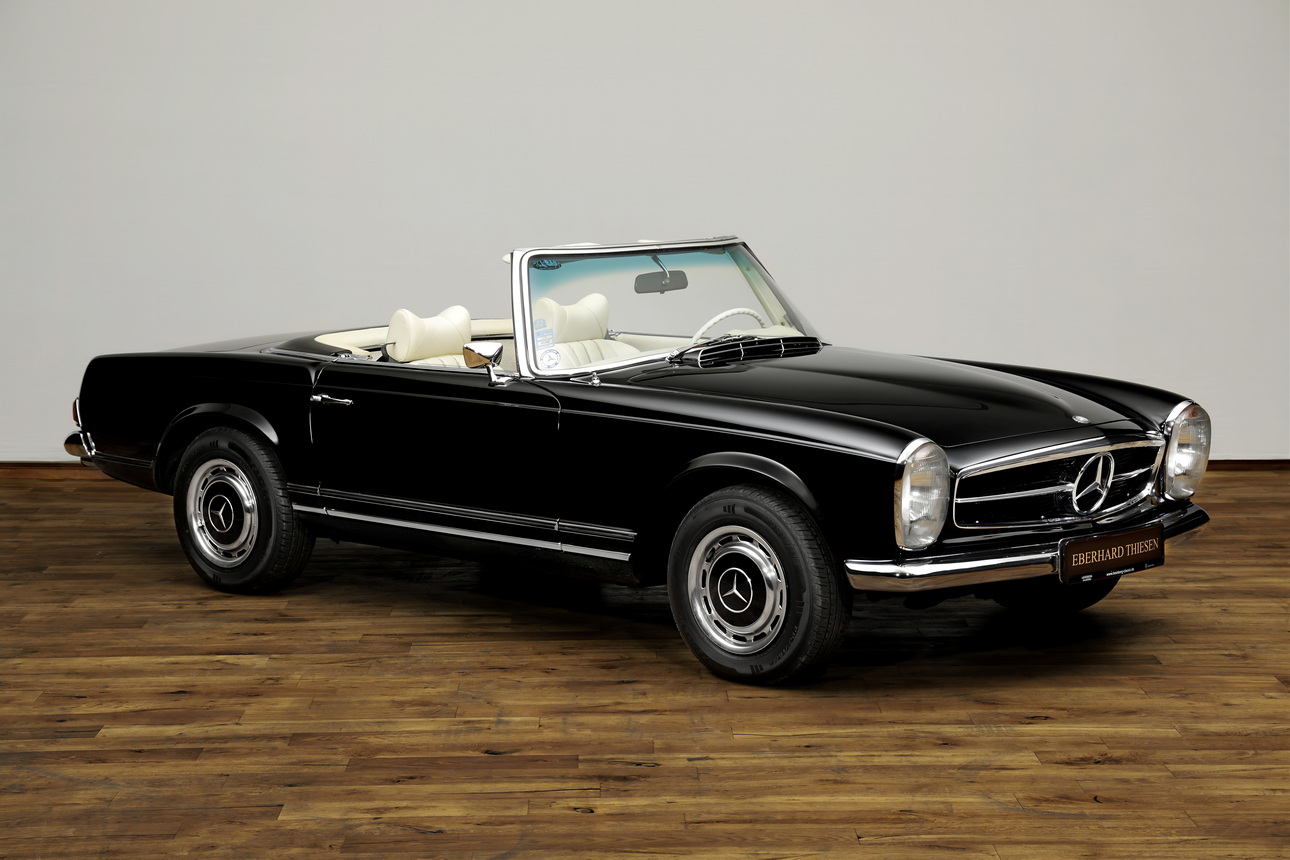Mercedes Benz 280 SL Pagode (W113)
Highlights
Daten & Fakten
Dieses Fahrzeug
Dieser Mercedes-Benz 280 SL aus dem Jahr 1969 besticht nicht nur durch seine zeitlose Eleganz, sondern auch durch seine gute Historie und den hervorragenden Zustand. Der Wagen verfügt über seinen originalen Motor mit „Matching Numbers“. Der Motor wurde in der Vergangenheit zudem vollständig revidiert und gewartet, sodass er einwandfrei läuft und beste Leistung bietet.
Die Lackierung des Fahrzeugs wurde in der Vergangenheit erneuert und präsentiert sich heute in einem glänzenden Schwarz (Farbcode 040), obwohl der Wagen ursprünglich in Signalrot (Farbcode 568) ausgeliefert wurde. Diese Veränderung verleiht dem Fahrzeug eine elegante, stilvolle Ausstrahlung. Die gesamte Karosserie zeigt sich in einem sehr guten Zustand, was auf eine sorgfältige Pflege im Laufe der Jahre hinweist. Das Verdeck des Mercedes Benz 280 SL wurde ebenfalls erneuert und befindet sich in einem sehr guten Zustand. Das Interieur in hellbeigem Leder ist vermutlich noch im Originalzustand und überzeugt durch seine hohe Qualität und den geringen Grad an Patina. Der authentische Charme des Innenraums bereichert die Ausstrahlung und das Fahrerlebnis zusätzlich. Ein Hardtop komplettiert die Ausstattung dieses Wagens.
Zur Verbesserung des Fahrkomforts wurde das Automatik-Getriebe gegen ein Modell aus der Baureihe R107 getauscht, da dieses Getriebe für eine noch geschmeidigere Gangwahl sorgt. Es ist jedoch möglich, das Originalgetriebe ohne Rückstände zurückzubauen, falls dies gewünscht wird. Der Zustand des Wagens wird durch eine im Jahr 2023 erneuerte Bereifung abgerundet.
Dieser Mercedes-Benz 280 SL wurde 1969 in die USA ausgeliefert und gelangte 1997 nach Deutschland zurück. Er verbrachte dann einige Jahre in Schweden und kam sodann wieder nach Deutschland. Das Fahrzeug wird mit einem umfangreichen Ordner voller Rechnungen sowie historischen Dokumenten übergeben. Aus dem Jahr 2010 existiert ein FIVA-Pass.
Dank der hervorragenden technischen und optischen Substanz zeigt sich das Fahrzeug in einem sehr guten Zustand. Es ist insbesondere für Liebhaber ein exzellentes Exemplar, das sich zum entspannten Fahren und Genießen bestens einsetzen lässt.
Modellgeschichte
Der SL der Baureihe W113 wurde im März 1963 auf dem Genfer Automobilsalon vorgestellt – und zwar als Nachfolger von gleich zwei erfolgreichen Modellen: dem 190 SL und 300 SL. So wurde neue SL als ein komfortabler, zweisitziger Reisewagen mit hohen Fahrleistungen und optimaler Fahrsicherheit konzipiert. Die technische Basis entsprach der Heckflossen-Limousine 220 SE mit dessen verkürzter und verstärkter Rahmen-Bodenanlage einschließlich Vorder- und Hinterradaufhängung. Als erster offener Sportwagen hatte der 230 SL eine Sicherheitskarosserie mit steifer Fahrgastzelle und verformbarer Front- und Heckpartie, den so genannten „Knautschzonen“.
Das charakteristische Designmerkmal dieser dritten SL-Baureihe war das abnehmbare Coupé-Dach. Dieses Hardtop war konkav, also nach innen gebogen, ausgeführt. Die damals sehr avantgardistische Gestaltung in Form einer „Pagode“ ermöglichte trotz Leichtbauweise eine besonders hohe Festigkeit des Dachs und sorgte mit großen Fenstern für verbesserte Sichtverhältnisse.
Der Reihen-Sechszylinder-Motor mit 2,3 Liter Hubraum kam auf eine Leistung von 150 PS im zuerst erhältlichen 230 SL. Alternativ zum 4-Gang-Schaltgetriebe war eine 4-Gang-Automatik und ab 1966 ein 5-Gang-Schaltgetriebe von ZF erhältlich. Im Februar 1967 löste der 250 SL den 230 SL ab. Sein Motor und die Bremsanlage stammten beide, leicht modifiziert, vom Typ 250 SE. Der Motor hatte 200 ccm mehr Hubraum und kam bei gleicher Leistung auf ein 10% höheres Drehmoment. Er war zudem mit sieben Kurbelwellenlagern sowie einem Ölkühler versehen. Die Bremsanlage hatte nun Scheibenbremsen auch an den Hinterrädern, größere Brems-scheiben vorn sowie einen Bremskraftregler. Bereits ein Jahr später erhielt der SL einen 2,8-Liter Motor. Gegenüber dem 250 SL stieg die Leistung auf 170 PS und das Drehmoment um 10%.
Im März 1971 lief die Produktion des W113 aus. Von den drei SL-Typen wurden bis dahin 48.912 Exemplare gefertigt. Aufgrund der charakteristischen Dachform werden die Modelle dieser Baureihe heute allgemein als "Pagoden-SL" bezeichnet.
Dieses Fahrzeug
Dieser Mercedes-Benz 280 SL aus dem Jahr 1969 besticht nicht nur durch seine zeitlose Eleganz, sondern auch durch seine gute Historie und den hervorragenden Zustand. Der Wagen verfügt über seinen originalen Motor mit „Matching Numbers“. Der Motor wurde in der Vergangenheit zudem vollständig revidiert und gewartet, sodass er einwandfrei läuft und beste Leistung bietet.
Die Lackierung des Fahrzeugs wurde in der Vergangenheit erneuert und präsentiert sich heute in einem glänzenden Schwarz (Farbcode 040), obwohl der Wagen ursprünglich in Signalrot (Farbcode 568) ausgeliefert wurde. Diese Veränderung verleiht dem Fahrzeug eine elegante, stilvolle Ausstrahlung. Die gesamte Karosserie zeigt sich in einem sehr guten Zustand, was auf eine sorgfältige Pflege im Laufe der Jahre hinweist. Das Verdeck des Mercedes Benz 280 SL wurde ebenfalls erneuert und befindet sich in einem sehr guten Zustand. Das Interieur in hellbeigem Leder ist vermutlich noch im Originalzustand und überzeugt durch seine hohe Qualität und den geringen Grad an Patina. Der authentische Charme des Innenraums bereichert die Ausstrahlung und das Fahrerlebnis zusätzlich. Ein Hardtop komplettiert die Ausstattung dieses Wagens.
Zur Verbesserung des Fahrkomforts wurde das Automatik-Getriebe gegen ein Modell aus der Baureihe R107 getauscht, da dieses Getriebe für eine noch geschmeidigere Gangwahl sorgt. Es ist jedoch möglich, das Originalgetriebe ohne Rückstände zurückzubauen, falls dies gewünscht wird. Der Zustand des Wagens wird durch eine im Jahr 2023 erneuerte Bereifung abgerundet.
Dieser Mercedes-Benz 280 SL wurde 1969 in die USA ausgeliefert und gelangte 1997 nach Deutschland zurück. Er verbrachte dann einige Jahre in Schweden und kam sodann wieder nach Deutschland. Das Fahrzeug wird mit einem umfangreichen Ordner voller Rechnungen sowie historischen Dokumenten übergeben. Aus dem Jahr 2010 existiert ein FIVA-Pass.
Dank der hervorragenden technischen und optischen Substanz zeigt sich das Fahrzeug in einem sehr guten Zustand. Es ist insbesondere für Liebhaber ein exzellentes Exemplar, das sich zum entspannten Fahren und Genießen bestens einsetzen lässt.
Modellgeschichte
Der SL der Baureihe W113 wurde im März 1963 auf dem Genfer Automobilsalon vorgestellt – und zwar als Nachfolger von gleich zwei erfolgreichen Modellen: dem 190 SL und 300 SL. So wurde neue SL als ein komfortabler, zweisitziger Reisewagen mit hohen Fahrleistungen und optimaler Fahrsicherheit konzipiert. Die technische Basis entsprach der Heckflossen-Limousine 220 SE mit dessen verkürzter und verstärkter Rahmen-Bodenanlage einschließlich Vorder- und Hinterradaufhängung. Als erster offener Sportwagen hatte der 230 SL eine Sicherheitskarosserie mit steifer Fahrgastzelle und verformbarer Front- und Heckpartie, den so genannten „Knautschzonen“.
Das charakteristische Designmerkmal dieser dritten SL-Baureihe war das abnehmbare Coupé-Dach. Dieses Hardtop war konkav, also nach innen gebogen, ausgeführt. Die damals sehr avantgardistische Gestaltung in Form einer „Pagode“ ermöglichte trotz Leichtbauweise eine besonders hohe Festigkeit des Dachs und sorgte mit großen Fenstern für verbesserte Sichtverhältnisse.
Der Reihen-Sechszylinder-Motor mit 2,3 Liter Hubraum kam auf eine Leistung von 150 PS im zuerst erhältlichen 230 SL. Alternativ zum 4-Gang-Schaltgetriebe war eine 4-Gang-Automatik und ab 1966 ein 5-Gang-Schaltgetriebe von ZF erhältlich. Im Februar 1967 löste der 250 SL den 230 SL ab. Sein Motor und die Bremsanlage stammten beide, leicht modifiziert, vom Typ 250 SE. Der Motor hatte 200 ccm mehr Hubraum und kam bei gleicher Leistung auf ein 10% höheres Drehmoment. Er war zudem mit sieben Kurbelwellenlagern sowie einem Ölkühler versehen. Die Bremsanlage hatte nun Scheibenbremsen auch an den Hinterrädern, größere Brems-scheiben vorn sowie einen Bremskraftregler. Bereits ein Jahr später erhielt der SL einen 2,8-Liter Motor. Gegenüber dem 250 SL stieg die Leistung auf 170 PS und das Drehmoment um 10%.
Im März 1971 lief die Produktion des W113 aus. Von den drei SL-Typen wurden bis dahin 48.912 Exemplare gefertigt. Aufgrund der charakteristischen Dachform werden die Modelle dieser Baureihe heute allgemein als "Pagoden-SL" bezeichnet.

